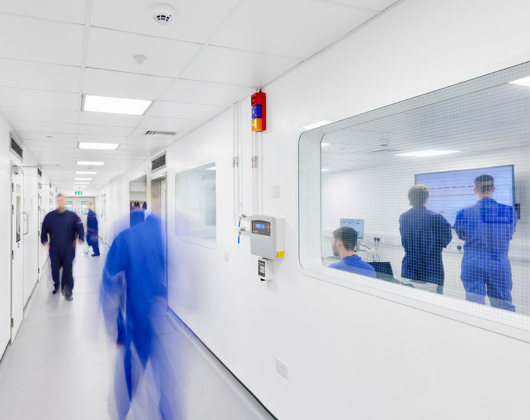In the previous blog post in this three-part series, we discussed how to design a safe and scalable synthetic route for your drug substance – Part 1: How do you design a safe and scalable synthetic route for your drug substance?
The next challenge is to develop a safe and efficient manufacturing process that is capable of consistently producing your drug substance at the intended quality on a larger scale. When developing a drug substance manufacturing process, considering the impurities that are produced is as important as the drug substance itself. You need to identify, quantitate, and ultimately control the impurities generated in the manufacturing process, as small differences in impurities can have a significant impact on the toxicological profile of the compound.
At Quotient Sciences, we have dedicated manufacturing suites in our state-of-the-art facility in Alnwick, UK, where an experienced team of process chemists works alongside colleagues in analytical chemistry and material science to support the manufacture of multi-kilogram quantities of Good Manufacturing Practice (GMP)-grade active pharmaceutical ingredient (API). Each cross-functional project team is overseen by a single project manager, who seamlessly manages the end-to-end process, provides regular status updates, and ensures timely project delivery for our customers.
We work with clients of all sizes, from small biotech companies to large pharmaceutical companies, tailoring our services to meet their specific project goals.
Once a suitable synthetic route has been chosen, we focus on ensuring that the chemistry can be safely and reliably carried out at a large scale, with process parameters (temperature, addition rates, reaction concentration, and stoichiometry) optimized to maximize reaction yield and throughput and ensure that the process is robust and scalable.
At this point, we use analytical chemistry to identify key process impurities. Our state-of-the-art analytical chemistry department has expertise in high-resolution mass spectrometry, solution- and solid-state nuclear magnetic resonance (NMR) spectroscopy, trace metal analysis, and gas and liquid chromatography. Having all these technologies under one roof allows us to gather important process information in real-time. By identifying key process impurities at an early stage, the chemistry team can make rapid modifications to the process to either prevent their formation altogether or develop purification processes to remove them. We also carefully analyze trace metal impurities, where relevant, as the International Council for Harmonisation of Technical Requirements for Pharmaceuticals for Human Use (ICH) guidelines have strict limits for the number of residual metals that can be tolerated in a drug substance. Homogenous transition metal catalysts based on palladium, rhodium, and iridium are commonly used to carry out useful synthetic reactions, so it is important to ensure that adequate purification steps are included in the drug substance synthesis to limit the quantity that remains in the drug substance.
Throughout this stage of development, our process chemists benefit from access to a range of parallel reaction equipment which, combined with in-situ reaction monitoring, allows us to quickly collect large amounts of data-rich experimental information, and make evidence-based decisions to develop the best possible process.
Once the process parameters have been determined, we perform the chemistry at an intermediate scale (typically 5 L) as a demonstration of the process. This confirms whether the developed process will perform as expected when carried out at a larger scale, using glass reaction vessels that mimic the layout of those found in our manufacturing suite. The drug substance that is generated in this demonstration batch is representative of the material that will be produced in the subsequent GMP campaign and can therefore be used to support stability studies of the drug substance as well as toxicology and formulation studies. Having successfully demonstrated the process at this intermediate scale, we will then carry out a GMP manufacture in our dedicated facility to produce the drug substance in the quantities required by our customer.
We have a dedicated team of flow chemists and chemical engineers who are continually assessing synthetic routes for opportunities to leverage our expertise in continuous technology.
The team develops chemical processes in flow which can offer numerous advantages over traditional batch chemistry and in some cases can even allow us to develop reactions that would not be possible to scale up in batch.
Our recent case study on the optimization of a flow process for a thermal rearrangement underscores the project timeline benefits that can be achieved when judicially incorporating flow processes at an early stage in drug development.
This is part two of our three-part series focused on scaling drug substance.
Continue reading part 1: How do you design a safe and scalable synthetic route for your drug substance?
Continue reading part 3: How do you successfully bridge into drug product development?
Learn more about our drug substance capabilities

